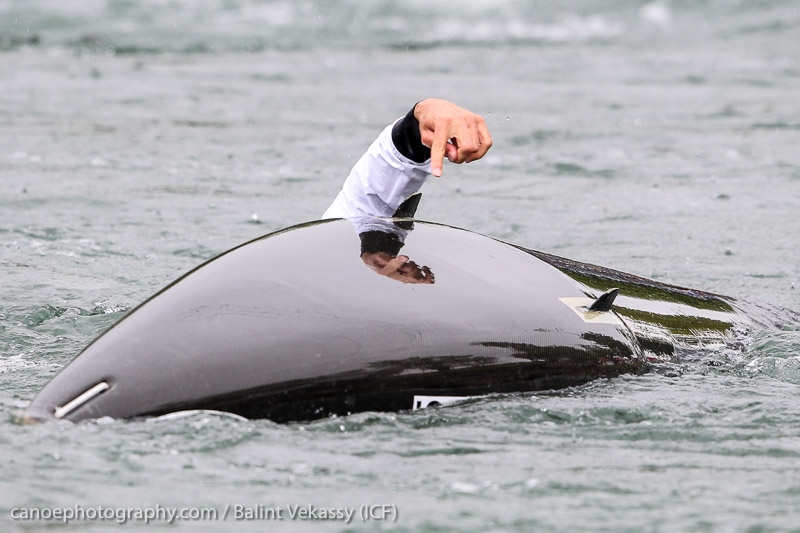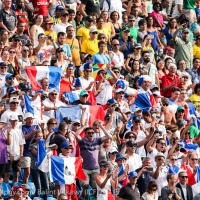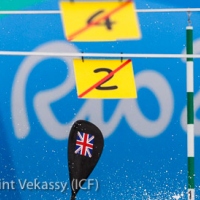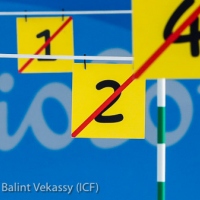Olympic canoe slalom - kayak classes
I will spend today and tomorrow looking at the different classes. There are four medal events at the Olympics; two kayak classes and two canoe classes. Here we look at the equipment, pros and cons and some top paddlers past and present.
K1M - Kayak Men’s Single
K1M is pronounced kay-one-men signifying a male athlete paddling a single one seater closed cockpit kayak.
The kayak paddler is sitting in a seat with the legs stretched out in front of them against moulded knee braces, foam padding and footrests. The footrests are potentially the most important fixture of the boat. It is not really possible to paddle down a whitewater course such as Deodoro without footrests and it would be almost impossible to negotiate the slalom gates. The kayak paddler is effectively wearing the boat rather than simply sitting in it and so transferring the power of the paddling to propel the kayak or change its direction.
Current World & European Champion Jiri Prskavec (CZE) says it is going to be tight. “I am sure everyone will go 100% and even small mistakes will make a big difference”, he said.
The rules of canoe slalom define the specification of the boats, in kayak this means the kayak must be 350cm long, 60cm wide and weigh no less than 8kg. With the shorter tighter course the kayak length reduced to 350cm. The single kayak is the fastest in a straight line, yet in slalom the boat rarely runs straight for more than a few strokes. Also the shorter boats, shorter and bigger whitewater courses mean that the run times are getting much tighter between K1M, C1M and C2M. With modern carbon construction it is quite feasible to manufacture the kayak less than 8kg. The boat is made up to the 8kg minimum weight by adding extra under the seat. This causes the boat to spin faster than it would do than if the weight were evenly distributed along its length. The kayaks will be weighed at the end of each run at the Olympic Games, to ensure that emptied of water they meet the required minimum weight. Joe Clarke (GBR) was disqualified with a fractionally underweight boat having won the Prague World Cup race.
32-year-old Peter Kauzer (SLO) comments that he feels comfortable in his boat “I trust it and then it’s easy to do things I want in it”.
Mike Dawson (NZL) says his boat has not evolved too much since his London Olympics before adding, “I’m enjoying the evolution of the boats in line with how the sports changed over the last 4 years to more dynamic attacking racing.”
In his book Every Second Counts, Jimmy Jayes described that K1M were doing an average 80 strokes per minute in the gates and up to 130 strokes per minute at the start and finish. Men generally have wider shoulders and slightly taller upper bodies and this means they have a greater muscle mass and longer levers than female paddlers. At times the men can rely on strength rather than superior technique.
The kayak paddles have a blade on each end, which are offset between 40-90 degrees either clockwise or anticlockwise. So paddlers are either left of right handed. Some paddlers use a cranked shaft which is not straight and is believed to reduce the strain on the wrist and allow greater pull. The paddles are all made of carbon which is stiff and transfers the power and helps pull the boat towards the blade.
The paddler wears a spraydeck which at this level are all made of neoprene. They are worn by the paddler around their chest/waist and seal around the cockpit of the kayak. They stop water getting into the boat. The paddlers legs and the inside of the boat remain dry and this also keeps the boat running fast as it is not carrying the extra weight of any water.
Several paddlers are also experimenting with fins attached to the bottom of the kayak. These are thought to assist with keeping the boat on track without interfering with the ability to whip around the red and white upstream gates.

The World Champions competing in Rio are:
- Jiri Prskavec (CZE)
- Peter Kauzer (SLO)
- Sebastien Combot (FRA)
The Olympic medallist competing in Rio is:
- Hannes Aigner (GER)
Legends of K1M
In K1M there has been a different champion at each respective Olympics although Germany has won three times since 1992 (Oliver Fix - 1996, Thomas Schmidt – 2000 & Alexander Grimm 2008) and Italy twice (Pierpaolo Ferrazzi 1992 & Daniele Molmenti 2012).
K1W – Kayak Women’s Single
K1W is pronounced kay-one-women, which signifies a female athlete paddling a single one seater closed cockpit kayak.

Women’s kayak is worthy of true recognition as they paddle the same 350cm kayaks as the K1M, on the same whitewater and through the same set of slalom gates. If you want to see the best use of whitewater watch the K1W. They have narrower shoulders and in theory less muscle mass and shorter levers. Their paddles (blades as we call them) are invariably about 10cm shorter.
Ladies thus rely less on brute strength and more on good technique and using the water to help them negotiate the gates. There have been a few exceptions Margit Messelhauser (GER) was incredibly strong while Liz Sharman (GBR) had great speed and a longer paddle.
Many K1W are deceptively quick. They maintain high boat speed through gates, with precise lines and keep the deck of the kayak dry. One of the best examples of this is Maialen Chourraut (ESP) who is regarded as the smoothest paddlers on the international circuit, pictured above. She was astonishingly close to the K1M winning run time at the Seu World Cup race this year. Jana Dukatova (SVK) also gains tremendous power off each stroke again with a controlled style.
Czech World Champion Katerina Kudejova thinks “I expect that the course will be difficult and it is very easy to touch gates or even miss it. I think many [K1W] will make mistakes, but the first 3 places will be tight.”
In his book Every Second Counts, Jimmy Jayes described that K1W were doing an average 70 strokes per minute in the gates and up to 80 strokes per minute at the start and finish, so less than the men, partly because they also tend to hang on to the stronger for a longer time.
The World Champions competing in Rio are:
- Katerina Kudejova (CZE)
- Jess Fox (AUS)
- Corinna Kuhnle (AUT)
- Jana Dukatova (SVK)
The Olympic medallists competing in Rio are:
- Jess Fox (AUS)
- Maialen Chourraut (ESP)
Legends of K1W
The most successful Olympic K1W have been double Olympic Champions Elena Kaliska (SVK) and Stepanka Hilgertova (CZE).
Keep tuning in
Tomorrow’s post will look at the Canadian classes of C1M and C2M.
We welcome your interaction. Remember to use hashtag #ICFslalom across all social media. Please comment through @PlanetCanoe on Twitter





